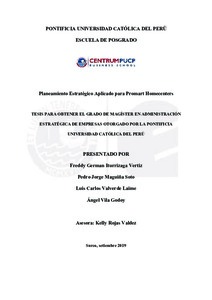| dc.contributor.advisor | Rojas Valdez, Kelly | |
| dc.contributor.author | Iturrizaga Vertiz, Freddy German | |
| dc.contributor.author | Maguiña Soto, Pedro Jorge | |
| dc.contributor.author | Valverde Laime, Luis Carlos | |
| dc.contributor.author | Vila Godoy, Ángel | |
| dc.date.accessioned | 2020-01-28T22:38:26Z | |
| dc.date.available | 2020-01-28T22:38:26Z | |
| dc.date.created | 2019-09 | |
| dc.date.issued | 2020-01-28 | |
| dc.identifier.uri | http://hdl.handle.net/20.500.12404/15803 | |
| dc.description.abstract | En el presente documento se ha desarrollado el Planeamiento Estratégico para
Promart Homecenters (Promart) donde se propone que para el año 2024 se disminuya la
brecha de participación de mercado frente a su principal competidor y que la propuesta
comercial omnicanal aumente la interacción positiva con el mercado objetivo y logre ser
reconocida como líder en el mercado retail de mejoramiento del hogar en el Perú. El plan de
expansión y la proyección tecnológica enfocada en la experiencia del cliente de manera
interna, como también el crecimiento de la industria de los centros comerciales en el país son
factores que ofrecen el panorama correcto para implementar este plan estratégico.
En conjunto con la gerencia, se han formulado seis objetivos de largo plazo hacia el
resultado del año 2024, (a) crecimiento de pedidos atendidos en ventas e-commerce a
150,000; (b) incrementar efectividad de atención de la cartera de clientes a 90% para el canal
de venta a empresas; (c) reforzar la experiencia de servicio y compra del cliente con mejores
respuestas operativas y canales de comunicación integrada con las tiendas físicas; (d)
establecer un sistema de capacitación técnica no mayor a siete días que mejore la brecha de
aprendizaje total; (e) para el 2024 se deberá mejorar el margen scan +1.5% para consolidar
marcas propias y alianzas estratégicas; (f) al mismo tiempo se deberá ejecutar la extensión de
la cantidad de productos nuevos exhibidos a más de 5,000 en el canal virtual.
Estos objetivos de largo plazo se han dividido en 12 objetivos a corto plazo (OCP)
que se describen en el tablero de control balanceado y se mantienen alineados con la visión,
misión y código de ética. Los objetivos de corto plazo están propuestos bajo indicadores de
gestión medibles y con enfoque en la experiencia del cliente, como, por ejemplo, la búsqueda
de optimizar el tiempo de capacitación integral de la fuerza de ventas; mejorar la
participación de la tarjeta Oh!; mejorar los tiempos de entrega de pedidos en todo el Perú y la
integración de herramientas de comunicación omnicanal en tienda física. | es_ES |
| dc.description.abstract | This document presents the development of the Strategic Plan for Promart
Homecenters (Promart) and set as main proposal the objective to reduce the market share gap
versus its competitors for the year 2024, consolidating the commercial operations of the
stores and the interaction of the omnichannel commercial proposal, in order to be recognized
as a leader in the home improvement retail Peru’s market. The expansion plan and the
competitive technological projection that currently flows up in the company, as well as the
growth of the retail industry in the country; all them offer the right environment to implement
this strategic plan.
Together with management, six long-term objectives have been stated towards the
expected result of the year 2024, (a) 150 thousands attended request for the growing of the ecommerce
sales; (b) increase the catchment effectiveness for enterprise sales portfolio up to
90%, achieving a better market share; (c) by 2024, the customer service and purchase
experience should be reinforced with better operational responses and integrated
communication channels; (d) a dynamic training system no more than five days must be
established for the sales team to improve the learning curve results; (e) as well as, by 2024,
the scan margin should be improved by + 1.5%, consolidating our own brands and alliances;
and (f) expand the exhibited products up to 5,000 items for the virtual channel.
These long-term objectives are divided into 12 short-term objectives (STO) that are
described on the balanced scored card and they are aligned with the vision, mission and ethics
codes. In addition, these STO will be monitored through measurable management indicators,
which are comfortably integrated from the perspective of sales force internal learning,
focused on customer experience and the improvement of the utilization of the Oh! credit card
and better product delivery times in match with the physical store. | es_ES |
| dc.language.iso | spa | es_ES |
| dc.publisher | Pontificia Universidad Católica del Perú | es_ES |
| dc.rights | info:eu-repo/semantics/openAccess | es_ES |
| dc.rights.uri | http://creativecommons.org/licenses/by-nc-nd/2.5/pe/ | * |
| dc.subject | Planificación estratégica | es_ES |
| dc.subject | Mercado retail | es_ES |
| dc.title | Planeamiento estratégico aplicado para Promart Homecenters | es_ES |
| dc.type | info:eu-repo/semantics/masterThesis | es_ES |
| thesis.degree.name | Maestro en Administración Estratégica de Empresas | es_ES |
| thesis.degree.level | Maestría | es_ES |
| thesis.degree.grantor | Pontificia Universidad Católica del Perú. CENTRUM | es_ES |
| thesis.degree.discipline | Administración Estratégica de Empresas | es_ES |
| renati.advisor.dni | 41038596 | |
| renati.advisor.orcid | https://orcid.org/0000-0002-4866-1671 | es_ES |
| renati.author.dni | 25745865 | |
| renati.author.dni | 32643606 | |
| renati.author.dni | 45430009 | |
| renati.author.dni | 42489487 | |
| renati.discipline | 413307 | es_ES |
| renati.level | https://purl.org/pe-repo/renati/level#maestro | es_ES |
| renati.type | https://purl.org/pe-repo/renati/type#tesis | es_ES |
| dc.publisher.country | PE | es_ES |
| dc.subject.ocde | https://purl.org/pe-repo/ocde/ford#5.02.04 | es_ES |






